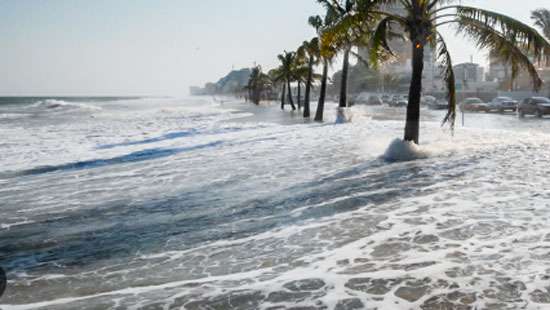Rising sea levels threaten Sri Lanka : 6,110 hectares to vanish by 2025

The sea level rise, triggered by climate change, will deprive Sri Lanka of 6,110 of land by 2025, and 25,000 hectares by 2100, an expert said yesterday.
Addressing a workshop under the theme ‘Climate Changes Impact on Health’ in Wadduwa, Kalutara, Dr. P.G. Hemantha Kumara who is the Vice President of Association of SAARC Food said Sri Lanka is ranked world’s second in the global climate risk index due to the high count of extreme weather events within a year.
The event has been organized by the Association of SAARC Food in Sri Lanka and World’s Poultry Science Association in collaboration with the United States Soybean Export Council in view of World Egg Day.
Referring to the severity of pollution committed in Sri Lanka, Dr. Kumara who is also the Deputy Director of the Horana Base Hospital said over 200,000 lunch sheets and about 150,000 polythene bags are used daily and the per capita per month consumption of polythene in Sri Lanka is about 0.5 kilos.
Commenting on the direct effects of climate change on health, he said it may be due primarily to increased temperatures and the frequency and intensity of heat waves.
“These effects are mediated by induction of heat stress conditions. Depending on its intensity and duration. Heat stress may negatively affect livestock health by causing metabolic alterations, oxidative stress, immune suppression, and death,” he said.
He said weather and climate change are likely to affect the biology and distribution of vector-borne infections. “For example, temperature changes, global wind and precipitation patterns, and changes in relative humidity in temperate climates will affect positively the reproduction of insects and, consequently, their population density,” he said.
Regarding its impact on animal health, for example, he said climate change can cause high motility rate of the chickens, low egg and meat production, emergence of new poultry diseases and its distribution and low quality, unhealthy eggs and meat.
This, according to him, affects food security.
As an expert, he stressed the need to have a health system that is prepared for prevention and responds with the increased anticipation of diseases and natural disasters.
According to him, between 2030 and 2050, climate change is expected to cause approximately 250,000 additional deaths per year from malnutrition, malaria, diarrhoea and heat stress. The direct damage costs to health (excluding costs in health-determining sectors such as agriculture and water and sanitation), are estimated to be between USD 2-4 billion/year by 2030. (Kelum Bandara)



